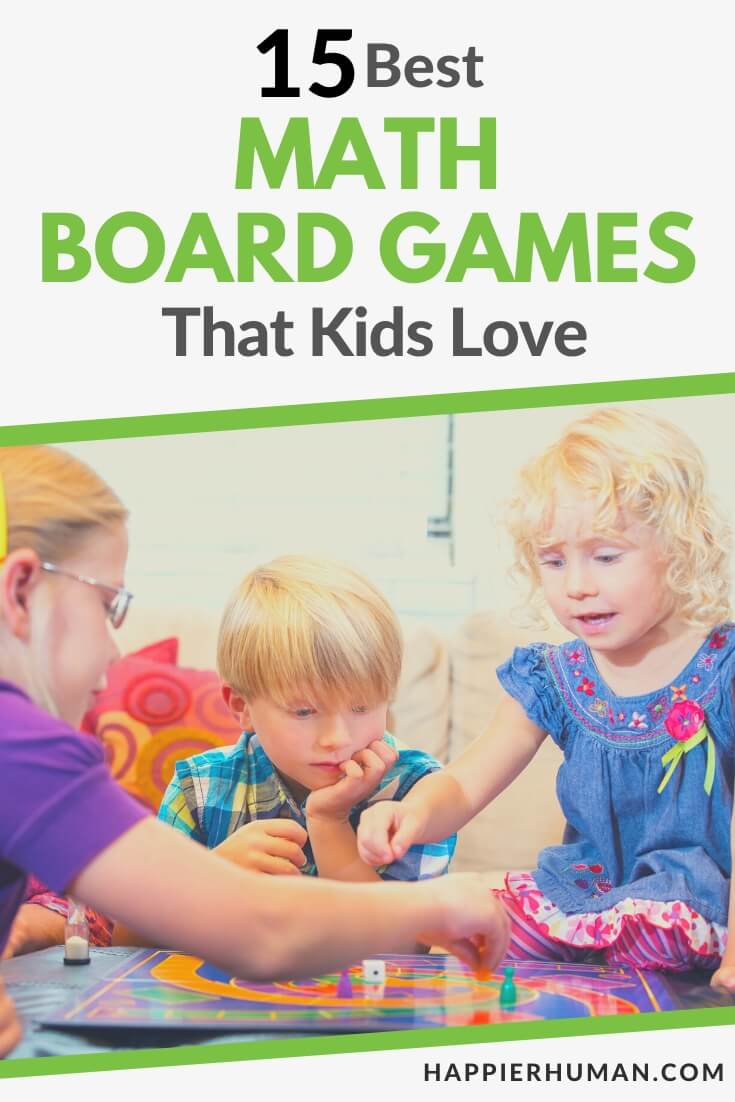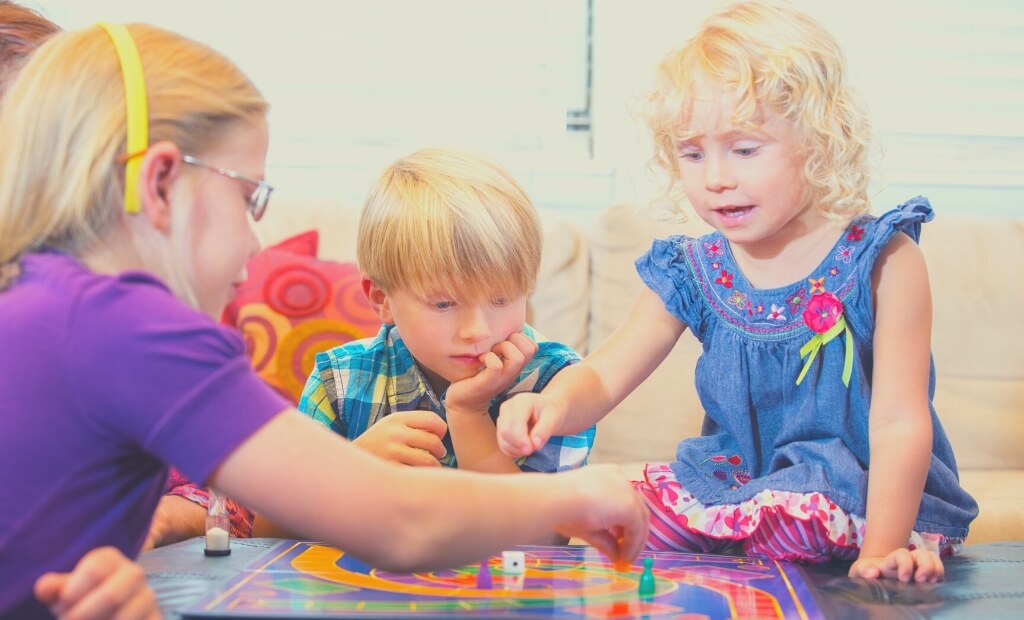There might be affiliate links on this page, which means we get a small commission of anything you buy. As an Amazon Associate we earn from qualifying purchases. Please do your own research before making any online purchase.
Are you looking for math board games for your kids?
Math may not be everyone’s favorite. Some people even avoid it. For others, however, it is the perfect subject to spend their time and effort on.
If you are a parent or teacher looking for a math board game that can help your children or students learn to love math, you’ve landed on the right page.
Today, we share 15 math board games that are proven to make mathematics easy and fun for kids.
Our list features a good combination of easy, moderate, and difficult options. Choose your game depending on your goals and your kids’ abilities.
Let’s get started!
1. Chutes & Ladders
Chutes & Ladders is an excellent game for both experts and beginners, adults and kids. It can accommodate a minimum of two and a maximum of four players, and is a classic math board game that requires no other skills except counting.
The rules of the game are pretty simple and straightforward. You simply need to spin the spinner and move your pawn up the ladder and down the chutes. The first person to climb and reach the top is the winner. The game is completely based on luck.
In addition to practicing numbers, this game can also help children distinguish good deeds from bad ones. A good deed is displayed on every ladder, while a bad deed is portrayed on each chute.
Pros:
Cons:
2. Hi Ho! Cherry-O
Here’s yet another classic game from Hasbro—Hi Ho! Cherry-O! It is suggested for children three years old and above and is one of the most highly-praised counting games.
Like the previously mentioned game, the rules are simple. Players only need to fill their buckets with fruit (pretend cherries), according to the number provided by the spinner. There is a twist, however, and that is that you have to put the fruit back on the ground if the spinner says so. The first person to fill their basket is the winner.
Children will surely enjoy learning numbers from this game. They will have so much fun that they might not even realize they are learning addition and subtraction!
Pros:
Cons:
3. Boom Goes the Dynamite
Boom Goes the Dynamite is a math-matching game. Each player’s mission is to find and collect matches, except with a lot of twists and turns.
The manufacturer advertises this game as an excellent gift idea for parents and teachers who wish to teach the foundations of math to their kids. The game involves both luck and memory, though it is best to have some sort of a strategy.
We highly recommend this fast-paced game to kids and adults alike. It can be played by a maximum of six and a minimum of two players and is best for kids ages 6 years old and up.
Pros:
Cons:
4. Sum Swamp
Sum Swamp provides kids with a fun and exciting way to practice their math skills. It has basic math drills that are perfect for homeschooling or classroom learning, and also has math challenges that aren’t overly complicated. Mostly, they make math more fun!
Each player’s goal is to race through the swamp while solving the drills, including addition and subtraction. New creatures are introduced every step of the way.
Sum Swamp is designed for two to four players, ages 5 years old and above. Guidance from adults is recommended, especially for kids who are not yet knowledgeable about math operations.
Pros:
Cons:
5. Money Bags
Money is a great way to teach math, and the game Money Bags makes sure that your kids learn and enjoy collecting, counting, and exchanging currency. It is also a good training tool for developing financial management skills.
The game set comes with a game board with a spinner, 100 plastic coins, pretend bills, dice, and markers. It is designed for a maximum of four and a minimum of two players and is perfect for children 7 years old and above.
Pros:
Cons:
6. Charty Party
Charty Party is a card game for those with “nerdy humor,” but it is also fun for “non-math people.”
This version is the “All Ages Edition,” which is an expansion pack for the original Charty Party game (which is meant for adults). However, it can be played solo without the original and is great for kids and teens in classroom or home settings.
Pros:
Cons:
7. Proof!
Proof is a fun, fast-paced math board game for two to six players, ages 9 and above. What makes it interesting is that its rules are adjustable if you have younger players or if prefer want solo gaming. The gameplay is rather short—around 15 minutes—and it is highly replayable.
We recommend this game for those who want to hone their children’s abilities in mental math. It has the elements of addition, subtraction, multiplication, and division. Some cards even have square root operations.
Pros:
Cons:
8. Pet Me
Pet Me is a fun board game that combines children’s love of math and animals. Players go on a park adventure, where they feed and take care of their pets (i.e., dogs, cats, etc.) while solving math challenges like multiplication and division. The game also focuses on mental math.
Pet Me is most appropriate for children ages 5 to 9, but it is adaptable for beginners and younger kids. It both has cooperative and competitive elements.
This award-winning game takes pride in being a high-quality STEM toy that focuses on children’s teamwork and social skills. It also promotes improved concentration and memory.
Pros:
Cons:
9. Super Math Spy
Super Math Spy is a great choice if you want to sharpen your kids’ ability to do mental math. It develops critical thinking and strategic planning skills, and is also a good source of entertainment because of the “spy” and “mystery” elements.
The manufacturer advertises the game as one that teaches kids the values of patience, honesty, and respect. In addition to basic math operations, like addition, subtraction, multiplication, and division, kids also learn how to exhibit appropriate behavior.
The game is designed for two to four players is highly recommended for those in second to fourth grade. However, its rules are adaptable and can accommodate younger children. It is suggested for both classroom and homeschool setups.
Pros:
Cons:
10. Mathemagical World
Those who love math know that it is magical, and this game celebrates that fact. There are eight unique magical worlds in this game: Desert Island, Dinosaur Island, Pirate Island, Zombie Island, Unicorn Island, Ice Island, Dragon Island, and Ninja Island. There are also two levels of difficulty and speed, both of which cover the concepts of addition, subtraction, doubling, and halving.
We recommend Mathemagical World for children who like fantasy and adventure. It might just teach them to love math, as well!
Pros:
Cons:
11. Adsumudi
Wondering what “Adsumudi” means? We thought it was a different language, until we realized that it is actually a combination of all the basic math operations! Indeed, the name of the game comes from ADdition, SUbtraction, MUltiplication, and DIvision.
Adsumudi is a board game that sharpens mental math skills and serves as an alternative to math practice workbooks and window card sheets. It is for kids 8 years old and above.
Like the previous games, this is an adaptable STEM toy with multiple difficulty levels. There are many ways to play it—individually, competitively, or collaboratively. It can even be played online, if you are interested in doing so.
Pros:
Cons:
12. Shut The Box
Shut the Box is the “perfect game to beat your boredom.” Its rules are simple, but the experience is thrilling and will keep you hooked for hours.
According to the manufacturer, this game is both a math and social entertainment game. It develops mental math and mathematical operations abilities, but it also improves thinking and logic, as well as response and emotion management.
The game set is perfect for travels and adventures. It is portable and lightweight, making it easy to carry around during outdoor activities like camping.
Pros:
Cons:
13. Clumsy Thief Junior
Clumsy Thief Junior is a game of stacking and snatching. There’s no need to worry about the “stealing” part, though, since the thief is a card and not a player. The goal is to simply stack food from the farm and catch the thief by using trap cards.
Kids will surely love this math board game because of its fun concept and interesting elements. The rules are quite simple, as they only need to count and add (and subtract if the thief steals their food). At the end of the game, the player with the most cards (food) wins.
Pros:
Cons:
14. Counting Peg
Counting Pegs is a board game for very young children, ages 3 to 6 years old. It is focused on counting mastery and number recognition. Children are taught how to do number matching and reordering, and basic arithmetic also comes into play if they use the set of flash cards.
We recommend this game for both classroom and homeschool setups. It is a great addition to the math games collection, particularly for those dealing with kindergarteners. If you want your kids to develop their number skills at an early age, this game is the perfect choice.
Pros:
Cons:
15. Wooden Multiplication-Addition Board Game
Wooden Multiplication-Addition Board Game has two functions: multiplication and addition. It helps children develop their number skills, particularly when it comes to identifying, adding, and multiplying. It also boosts their imagination and strengthens their hand-eye coordination.
What is fascinating about this simple yet functional board game is that there are various ways to play it. You can even create your own rules if you want—the manufacturer even encourages players to do so!
Pros:
Cons:
Final Thoughts on Math Board Games
Not everyone loves math, but it is an integral part of life and something that all kids need to learn. Why not start them young and give them a fun way to learn?
We hope that, through this list, you were able to choose the math board game that is most suitable for your children. If one doesn’t work, you can always try the others!
And if you're looking for more fun board games for kids to play with, be sure to check out these blog posts:
- 9 Fun Cooperative Board Games for Kids
- 9 Best Board Games for 5 to 6 Year Olds
- 23 Best Board Games for Kindergartners

















